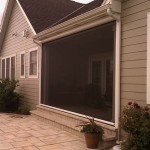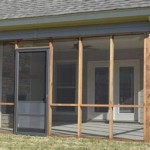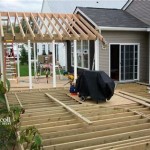Patio Makeover: Before and After Transformations
A patio serves as an extension of the home, a space where relaxation, entertainment, and connection with the outdoors seamlessly blend. However, over time, patios can become worn, outdated, and generally uninviting. A well-executed patio makeover can breathe new life into this outdoor space, significantly enhancing its functionality, aesthetics, and overall value. This article will explore common issues that necessitate a patio makeover, analyze key planning considerations, and illustrate the profound impact of thoughtful design choices through before and after examples.
Patios, being exposed to the elements, are susceptible to various forms of degradation. Sun exposure can fade and crack paving materials. Rain and humidity can lead to mold and mildew growth, creating slippery and unsightly surfaces. Over time, the underlying structure may shift, causing uneven pavers and drainage problems. Moreover, outdated designs and inadequate space planning can render a patio functionally obsolete, failing to meet the evolving needs of the homeowner.
The benefits of a patio makeover extend far beyond mere cosmetic improvements. A refreshed patio can increase the usable living space of a home, providing an attractive and functional area for outdoor dining, lounging, and socializing. A well-designed patio can also enhance the curb appeal of a property, potentially increasing its market value. Furthermore, a revitalized patio can promote a healthier lifestyle by encouraging outdoor activities and providing a relaxing escape from the indoor environment.
Assessing the Existing Patio and Identifying Needs
The first step in any patio makeover is a thorough assessment of the existing structure and an objective evaluation of its shortcomings. This involves a detailed inspection of the paving materials, the underlying structure, and the overall layout. Cracks, uneven surfaces, and drainage issues should be meticulously documented. It is also essential to consider the surrounding environment, including the landscaping, the house's architectural style, and the amount of sunlight the patio receives.
Following the physical inspection, the homeowner should carefully consider their specific needs and desires for the redesigned patio. What activities will the patio be used for? Will it primarily serve as a space for outdoor dining, relaxation, or entertaining? How many people will typically use the patio at one time? What is the desired aesthetic? These questions will help to define the scope of the project and guide the design process.
Budgetary constraints also play a crucial role in determining the feasibility of different design options. It is important to establish a realistic budget early on and to prioritize the most important improvements. Material costs, labor expenses, and permit fees should all be factored into the overall budget. It is often advisable to obtain multiple quotes from different contractors to ensure competitive pricing.
Key Design Considerations for a Patio Makeover
Once the assessment and planning phases are complete, the design process can begin. Several key considerations should be carefully evaluated to ensure a successful and functional patio makeover.
Material Selection: The choice of paving materials is a critical decision that will significantly impact the aesthetic appeal, durability, and maintenance requirements of the patio. Common options include concrete pavers, natural stone, brick, and composite decking. Concrete pavers offer a wide range of colors, shapes, and textures, and are relatively affordable. Natural stone, such as flagstone and limestone, provides a more rustic and elegant look, but tends to be more expensive. Brick offers a classic and timeless appeal, while composite decking provides a low-maintenance and durable surface.
Layout and Space Planning: The layout of the patio should be carefully planned to maximize functionality and create a comfortable and inviting space. Consider the placement of furniture, walkways, and landscaping. Ensure that there is adequate circulation space and that the layout promotes a natural flow of movement. For smaller patios, consider using space-saving furniture and vertical gardening to maximize the available area. For larger patios, consider dividing the space into distinct zones for different activities, such as dining, lounging, and grilling.
Lighting and Shade: Proper lighting and shade are essential for creating a comfortable and usable patio. Lighting can extend the usable hours of the patio into the evening and create a warm and inviting ambiance. Options include string lights, path lighting, and spotlights. Shade is crucial for protecting occupants from the sun's harsh rays during the day. Options include pergolas, awnings, and umbrellas. Consider the orientation of the patio and the amount of sunlight it receives when selecting shade options.
Landscaping: Landscaping can significantly enhance the aesthetic appeal and functionality of a patio. Plants can provide privacy, shade, and visual interest. Consider incorporating a variety of plants with different textures, colors, and heights. Choose plants that are well-suited to the local climate and soil conditions. Consider incorporating potted plants, raised garden beds, and vertical gardens to add visual interest and maximize the available space.
Before and After Examples of Successful Patio Transformations
The transformative power of a patio makeover is best illustrated through before and after examples. These real-world case studies demonstrate how thoughtful design choices can completely revitalize an outdoor space.
Example 1: From Cracked Concrete to Elegant Stone Patio
Before: The original patio consisted of cracked and discolored concrete, with minimal landscaping and outdated furniture. The space felt uninviting and lacked a sense of purpose.
After: The concrete was replaced with elegant flagstone pavers, creating a warm and inviting atmosphere. A custom-built pergola provides shade and visual interest. Comfortable outdoor furniture and lush landscaping complete the transformation, creating a relaxing and stylish outdoor living space. The addition of outdoor lighting allows for enjoyment of the patio well into the evening.
Example 2: Transforming a Small Balcony into an Urban Oasis
Before: A small, neglected balcony with a rusty railing and bare concrete floor offered little appeal.
After: The balcony was transformed into a charming urban oasis with the addition of composite decking, a modern railing, and lush potted plants. A small bistro set provides a cozy spot for enjoying morning coffee or evening cocktails. The use of vertical gardening maximizes the limited space and creates a sense of privacy.
Example 3: Updating an Overgrown Patio into a Functional Entertainment Space
Before: An overgrown patio with uneven pavers and inadequate seating made entertaining guests challenging. The space was cluttered and lacked a cohesive design.
After: The patio was completely redesigned with new concrete pavers, a built-in outdoor kitchen, and ample seating. A fire pit creates a focal point and provides warmth on cool evenings. The landscaping was streamlined to create a more modern and manageable design. The enhanced patio now serves as a functional and inviting entertainment space.
These examples highlight the potential of a well-executed patio makeover to transform an uninviting and underutilized space into a valuable asset for the home. By carefully considering the needs of the homeowner, paying attention to key design considerations, and selecting appropriate materials, a patio can be transformed into a beautiful and functional outdoor living space.
The process of a patio makeover can involve demolition of existing structures, which may require permits depending on local regulations. Prior to undertaking any significant work, consulting with the local building department is advisable to ensure compliance with all applicable codes and ordinances. Additionally, homeowners associations often have specific guidelines related to exterior renovations, and these should be reviewed and adhered to.
The integration of smart technology can further enhance the functionality and convenience of a patio. Smart lighting systems can be programmed to automatically turn on and off at specific times, while smart irrigation systems can optimize watering schedules based on weather conditions. Outdoor speakers can provide entertainment, and smart thermostats can control the temperature of outdoor heaters or cooling systems.

Back Patio Makeover Full Reveal Source List Liz Marie Blog

Home Style Challenge Fall Festival Patio Makeover

Unbelievable Diy Backyard Before After Transformation Budget Friendly

Home Project Backyard Patio Makeover

The Backyard Makeover Reveal An Oregon Cottage

Before And After 5 Inspiring Porch Patio Makeovers

Our Backyard Makeover Before And After Pictures Making Maanita

The Rainforest Garden My Backyard Oasis Makeover Before And After

The Best Backyard Makeover Ideas Of 2024 Purewow

20 Inspiring Backyard Makeovers Jenna Sue Design








